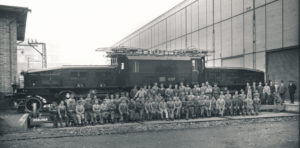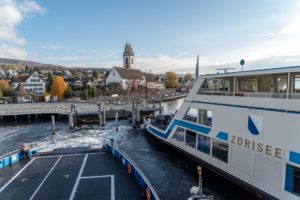
©Archiv der Luftschiffbau Zeppelin GmbH
Swift ascent at Lake Constance
On 2 July 1900, the world watched spellbound as events unfolded at Lake Constance. At 8 p.m., Ferdinand Zeppelin’s first airship floated into the sky. Despite a few minor issues, the machine amazed people across the globe.
When Count Zeppelin launched his first airship from the Bay of Manzell on 2 July 1900, he must have been aware that it was a momentous occasion. He had made sure there was plenty of publicity in anticipation of the great event. Happily, there was no big bang, despite the explosive hydrogen – the only lifting gas possible at the time – but the engines certainly boomed and pounded deafeningly.
Curious onlookers had flocked to Lake Constance from every corner of Europe. Among the spectators, celebrities and illustrious figures from European airship travel, science, politics, industry and the nobility rubbed shoulders with high-ranking military officers from Württemberg and Prussia. The little town of Friedrichshafen was bursting at the seams. There was a carnival atmosphere.
Across the lake on the opposite Swiss shore too, people gathered to watch the first ascent. They included a handful of scientists, who wanted to see how high the wonderful new aircraft would rise. The floating hangar alone was so enormous that everyone was curious to see just what the mysterious craft would look like. The technical work on the airship had mostly been done in secret, and only specialist professionals and financial backers had been allowed to ‘inspect’ it. It wasn’t until the end of June that some people were able to catch a glimpse of the airship, as the Count had walked it out of the hangar and back in again a couple of times. What would it look like in the air? Would it actually be able to fly? Wasn’t it too dangerous?
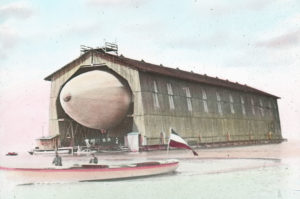
Count Zeppelin kept his airship hidden away until shortly before its launch.
©Archiv der Luftschiffbau Zeppelin GmbH
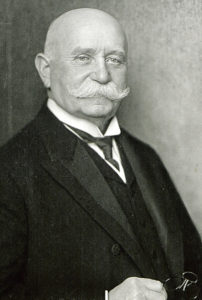
Ferdinand von Zeppelin, photographed in 1917.
Wikimedia / Staatsbibliothek zu Berlin
PROBLEMS AT THE LAUNCH
Count Zeppelin had chosen his team carefully: in addition to himself, Baron Konrad von Bassus and engineer Burr were in one gondola. In the second gondola were machine operator Groß, and journalist and Africa explorer Eugen Wolf. The holding team consisted of members of the fire brigade and the sports club.
It’s hard to imagine the tension everyone must have been feeling. The launch, scheduled for 1 p.m., was postponed to 8 p.m. Count Zeppelin gave a short speech and said a prayer for protection. And then everything was ready to go! The exit from the floating hangar went smoothly, but then suddenly there were problems, as reported by Count Zeppelin:
‘Due to two mooring ropes at the rear being held for too long, that end lagged behind when the craft started to ascend. As soon as the ropes were released, the moveable weight was brought forward. As a result, the vehicle swung back against the horizontal and, having arrived in that position, reached its greatest speed during the trial, since the propellers were now also running forwards. At that juncture, it was advancing rapidly against the direct headwind of 5.5 metres a second (reading at the tethered observation balloon). But that brief moment was much too short to allow the craft to reach anything even approximating its real top speed.
In the endeavour to bring the moveable weight back into the central position the crank lever for doing so broke, and the craft immediately dipped with the tip pointing downwards. This was followed by a turning moment caused by a slight curvature of the longitudinal axis (approx. 27 cm at 128 m aircraft length) which, because of the broken crank lever, could not be counteracted with the moveable weight. Now the impending risk of overturning had to be counteracted immediately by stopping the propellers and running them in reverse. From that point onwards, all movement consisted of alternating between running the propellers forwards and in reverse, in order to prevent too steep a gradient.’
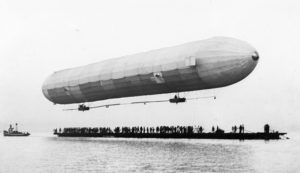
The launch of the airship was delayed by several hours to 8 p.m.
@Archiv der Luftschiffbau Zeppelin GmbH
MORE PROBLEMS WITH THE LANDING
The Count also wanted to find out how much gas and petrol the aircraft consumed. For everyone else, it was a spectacle. Those who were particularly fortunate were able to grab a space on one of the numerous escort vessels, to get as close as possible to the airship and the floating hangar. Everyone else stood clustered on the shore. Some took photographs, while others sketched what was happening. And there was plenty to sketch, because landing the airship also turned out to be problematic, as the regional newspaper Seeblatt reported:
‘When the craft descended after about 20 minutes, something seems to have malfunctioned with the steering mechanism, and the descent was rapid, in order not to come in to the land. […] The balloon, or the two gondolas, landed on the lake close to the shore at Immenstaad. In doing so, the balloon came into contact with a post associated with the steamboat rides, and the envelope received a tear.’
The collision with the post had slightly damaged the airship. Nevertheless, this first ascent earned Count Zeppelin enthusiastic plaudits not only in the Lake Constance region, but also in the international press. One female fan even called him the greatest man of the century. But it shows how excited people were about this technical marvel.
For the international Lake Constance area this big entrance had a lasting effect, with the locale developing into what is still an important industrial region and deservedly referred to as an ‘engineering Mecca’. The town of Friedrichshafen also benefited from this momentous day, with a massive increase in its population. Today, more than 60,000 people from 128 countries live there. The Count would have been delighted!
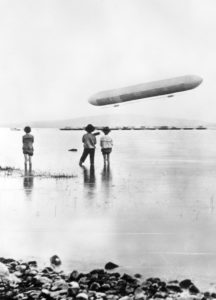
No one at Lake Constance missed the airship’s maiden journey.
@Archiv der Luftschiffbau Zeppelin GmbH


